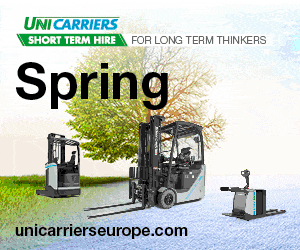Designing a competitive warehouse and supply chain today isn’t a simple task. From the outset, businesses are required to be agile and flexible while also staying streamlined and focused in order to achieve high volumes and consistent quality.
For many brands, successful logistics is a juggling act – while the demand for capacity and getting products from raw material to finished product on-shelf remains a top priority, there is a continued drive for supply chains to be more sustainable.
Crucially, consumers are going under the skin of sustainability. It’s no longer enough for end products to be built from responsible materials or provided with recyclable packaging, shoppers want to know that they’re supporting a sustainable supply chain too.
When we consider the role that sustainability plays in modern industry, it’s difficult to see it as anything other than a self-perpetuating situation. Brands promote sustainability as part of their core values, which connect with consumers, and then create a mindset wherein environmental awareness becomes a marketing driver, not necessarily a true force for good. The end result is a very fractured and inconsistent concept of ‘sustainability’ that is far too open to interpretation.
The Green Claims Code as a barometer
The recently launched Green Claims Code, a guideline document created by the Competition & Markets Authority (CMA) has underlined just how seriously the topic of sustainability is being taken. Following the discovery that around 40% of ‘green’ claims could be misleading to the consumer, the guide is designed to tackle the ongoing problem of greenwashing.
The document is right on time – one of the major challenges for brands today is that through adulteration and misuse, the umbrella term ‘sustainability’ has lost all weight and meaning. When the supply chain is closer, more interconnected and more transparent than ever before, retailers must ensure that real and measurable sustainability is at the forefront. This, of course, makes it a top priority for the system integrators and digital automation specialists that are creating the warehouse of the future.
Over many years, the growth of greenwashing hasn’t just affected the consumer, supply chain sustainability has been at risk of becoming an echo chamber; simply a tick box exercise for brands and retailers to demonstrate awareness of their environmental impact. This has resulted in a largely surface-level environmental push, where data is kept and stored but isn’t turned into anything more meaningful.
The overarching message of the Green Claims Code is that sustainability is to be taken more seriously, with greater emphasis on integrity and transparency. While the code seems to be purely consumer-oriented at first glance, it actually brings a host of benefits to brands and retailers, such as levelling the sustainability playing field and restoring consumer trust.
So, in the face of growing calls to create a holistically more sustainable supply chain, what is the next step for system integrators and the brands they serve?
Making sustainable intralogistics measurable
One way to move supply chain sustainability forwards in a more tangible way is through intralogistics. The handling, movement and storage of goods and components is often an ‘unsung hero’ of the supply chain, less glamorous than automated high-tech production lines but usually not consumer-facing either. However, intralogistics plays an enormous role in how a business monitors and reduces its environmental impact.
When looking to how best to break through the sustainability status quo and deliver more meaningful gains, we have to consider the role of containers, dollies and trays. In light of the significant cardboard shortages, we are seeing more brands switch to plastic alternatives. After years of vilification in the media, plastic as a substrate is becoming a much more palatable prospect, consuming less energy in its lifetime than the equivalent cardboard, as confirmed by life cycle assessments (LCAs).
Warehouse designs can be built around more sustainably oriented intralogistics, which can be as simple as choosing durable plastic containers. As well as being more hard-wearing than the humble cardboard box, the solutions offered by Schoeller Allibert can close the packaging loop. Being made from recycled plastic, the products can be collected and recovered into new packaging at the end of their service life too. This deceptively simple process, which generates percentage savings over its lifetime, gives a new opportunity to make supply chain sustainability more measurable.
For example, the Carton Federation of France estimates that through its lifespan, one ton of corrugated cardboard generates the equivalent of 538kg of carbon dioxide – no small amount. By way of comparison, research conducted by the US Environmental Protection Agency found that on average, the amount of energy used to create plastic is 40% lower than that of cardboard or cartonboard. With a consumer base that is more knowledgeable and inquisitive than ever before, promoting significant sustainability gains such as this can be a powerful tool to support a ‘greener’ brand narrative.
A great example is SASI®, our collection of durable recycled plastic containers designed to directly meet the needs of system integrators and warehouse automation specialists. Available in 5 sizes, SASI isn’t just a more sustainable way of handling and transporting goods or components through a warehouse facility, it brings a host of other advantages too, such as a wider noise-reducing base, ergonomic handgrips and divider locations for up to 8 compartments.
Of course, we’re not just designing with today’s needs in mind, but tomorrow’s as well. SASI features integrated pick-up points for automated handling and the ability to withstand temperature extremes – it’s a versatile and powerful choice for today’s competitive supply chains, and a robust and forward-thinking packaging solution for system integrators. Breaking through surface level sustainability takes a sharp focus on technologies such as SASI, which as well as being a more eco-conscious choice for system integrators and warehouse automation specialists, brings efficiency, safety and security benefits too.
The time for real change is now. The launch of the Green Claims Code lays bare the changing nature of sustainability. The guidance highlights that in making claims, brands need to consider the full life cycle of the product or service, including how it is produced and carried out, as well as transported from its place of manufacture. To bust through the echo chamber and make a real difference, system integrators must take a more targeted view of sustainability, building facilities around the intralogistics technology on the table, rather than building this on at a later point. By doing so, the brands they serve can truly put ‘green’ operations at the heart of the supply chain, with the data and credentials to back it up. If we aim for sustainability, transparency and integrity, commercial appeal and compliance will follow naturally.
At Schoeller Allibert, we specialise in helping businesses find the ideal solution from the production line to the warehouse and shop floor. With over 60 years of innovation, Schoeller Allibert’s product portfolio makes it easy to meet the changing needs of the market, uplift efficiency transparency and safety and create a more sustainable supply chain in the process.
Jon Walkington, Sales Director, Retail & Systems Integrators, at Schoeller Allibert UK
To find out more about the latest innovations in RTP from Schoeller Allibert, please visit www.schoellerallibert.com/uk






